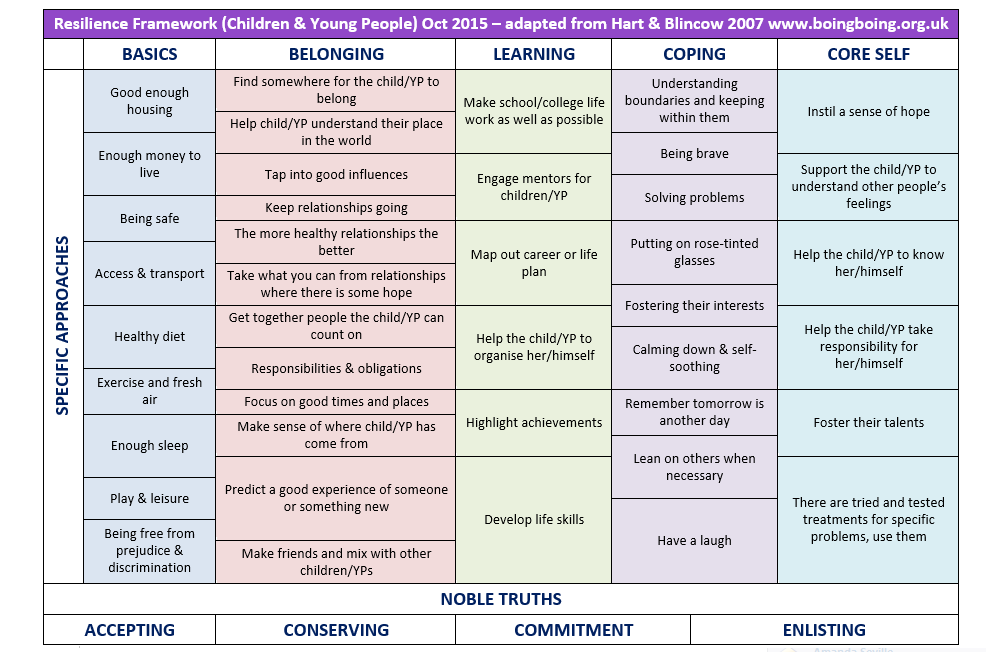How to use the Resilience Framework
The Resilience Framework summarises a set of ideas and practices that promote resilience.
It is based on a body of research and practice development called Resilient Therapy (RT). We distilled what the research base said into a handy table that summarises our approach and acts as a reminder to people of what’s included. So while the Resilience Framework Summary Table does look pretty simple, there’s quite a lot of work behind it.

The Five Compartments
The Summary Table visually shows you how we have split our ideas under five headings or compartments to help us think strategically and practically about doing things resiliently. Within each of these compartments is a selection of evidenced based ideas or remedies, to draw on when trying to make a resilient move with a child, young person, family or adult. You can find out more about each compartment below:
Basics
The resilience research base didn’t have that much to say about the basic things we need in life to get by, but from our practice and parenting experience, we think that attending to the Basics is seriously important. So the ideas in this section are all about sorting out seemingly simple things. But as anyone who’s ever had no fixed abode will know, having a decent roof over your head is something worth prioritising. And for some people, it’s no good going on about other things in their life, like careers or school work for example, unless you get some of these basics sorted first.
Belonging
This puts good relationships at the heart of things. It focuses on reminding us to have and look after healthy relationships and to tap into good influences instead of bad ones. It recommends concentrating on the good times and places, find people we and our children can count on and remain hopeful about building new contacts.
Learning
The importance of finding out about and discovering new things. So it’s not just about sorting a child’s schooling, although this is really important, it’s also about less formal ways of learning, like making sure we develop interests, talents and life skills. It encourages us to follow up new and old interests, dare to have a vision for a life plan or a future full of doing new things. It reminds us of the value of getting organized, noticing our achievements and developing new skills.
Coping
This is all about those things we and our children do to help us get by in everyday ways. Like those times when we need to be brave, solve problems and stand up for our own views and beliefs. It’s about putting on rose-tinted glasses when we need to, looking after our talents, finding ways to stay calm, remembering that tomorrow’s a new day and leaning on others when its necessary.
Core Self
This puts the focus on our inner worlds – those thoughts and beliefs we have about ourselves that build our characters. This compartment concentrates on ways of being hopeful, finding our own sense of morality, using all of our senses to get a good solid idea of who we are. It encourages us to take responsibility for ourselves, face problems and seek help when it makes sense to do so.
The Noble Truths
We also have a group of four ‘noble truths’ that underpin these 5 compartments and their resilient moves. These are those fundamental starting places we need if we are interested in building resilient capital with children, young people, families and adults. They encapsulate the underlying beliefs, values and attitudes needed to make RT work and include: acceptance, conservation, commitment and enlisting. While not unique to RT – you’ll find them in some shape or form in most therapeutic schools of thought including for example, Rogerian, psycho-dynamic, cognitive behavioural and family therapy approaches – they are essential to successful RT work.
Accepting
Starting with exactly where a child, young person or family is at, even if it means being at a very sore point. Returning to ‘unconditional positive regard’, which means trying not to judge people and appreciating them or their basic humanity come what may.
Conserving
Holding on to anything good that has happened up until now and building on it. When there is so much difficulty around, preserving the little positive that there is becomes even more precious.
Commitment
Staying in there and being explicit about what your commitment can be. Being realistic about what’s doable, and not giving up or expecting things to change overnight.
Enlisting
Seeking others to help, and moving on from those who might have let us down in the past, noticing that we may not be enough or we may be too much.
You can also find more detailed information about each element of the Resilience Framework on our Interactive Resilience Framework which is designed to be user-friendly, allowing you to click on areas that interest you to find out more. It was developed especially for working with schools, holding the children and young people in mind, and is one of the resources from the Academic Resilience Approach.
If you really want to get stuck into understanding how we put the Resilience Framework together, and get more detailed information about how to use it, you might want to get hold of one of our books.